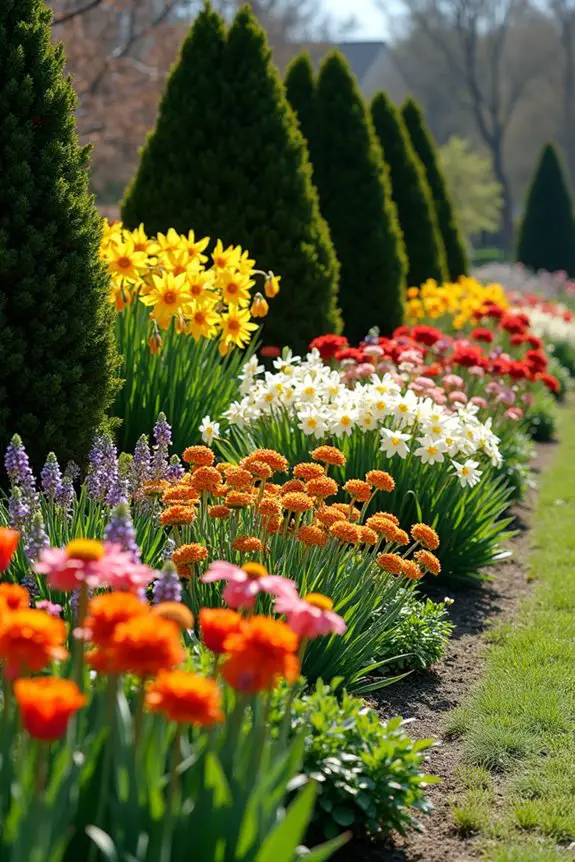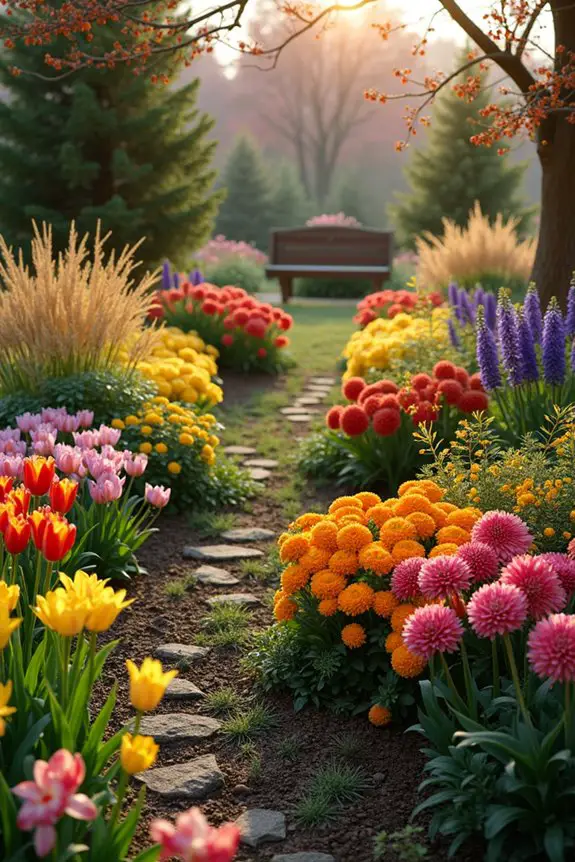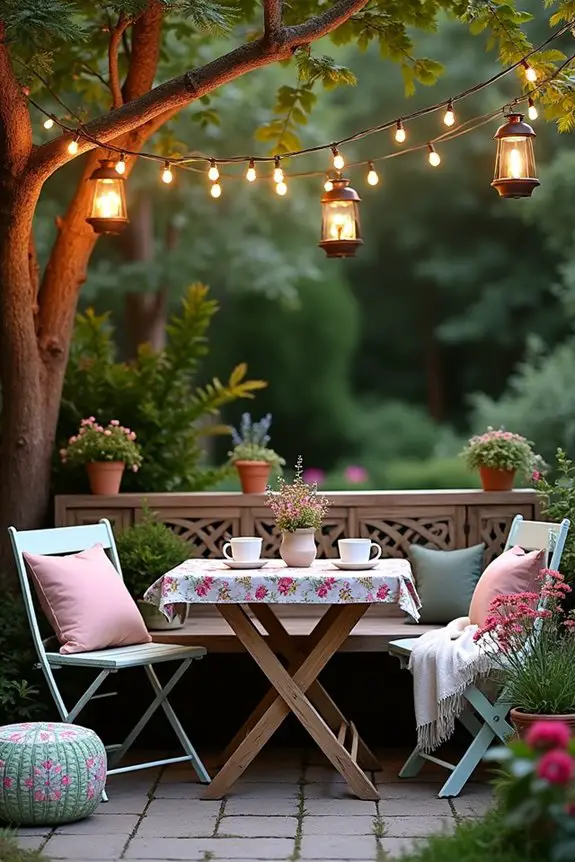Imagine your small garden as a colorful tapestry, each plant weaving its own story into a vibrant scene. Finding the right design for limited space can feel like piecing together a puzzle, but it doesn’t have to be stressful. Have you ever thought about how vertical structures can transform the way your space feels? Let’s explore some ideas that turn your cozy nook into a stunning retreat, while hopefully avoiding any gardening disasters along the way.
The Colorful Flower Beds
When it comes to creating colorful flower beds, you’ve got some fun options to explore.
Think about how vertical garden structures can save space while adding layers of vibrant blooms, or imagine a charming pathway that leads friends through a burst of colors.
You might even consider container gardens that let you mix and match plants—who knew gardening could be so much like playing with Legos?
1. Vertical Garden Structures
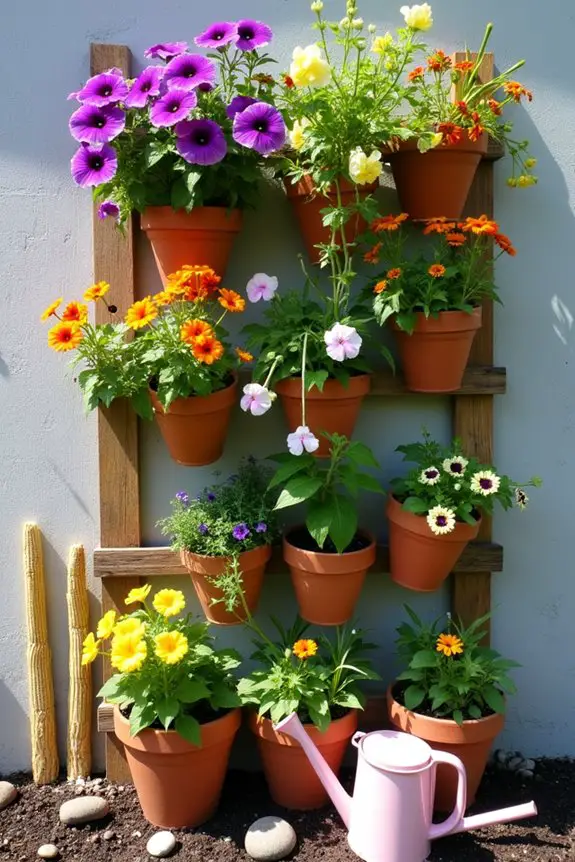
Vertical garden structures are a super smart way to make the most out of limited space while adding a pop of color to your small garden. They’re not only functional, helping you maximize your garden area, but they also create a lively atmosphere that can brighten up even the dullest corners.
Imagine stepping into your garden and being greeted by a stunning display of flowers cascading down a trellis or climbing up a wall. Who wouldn’t feel a little more cheerful? Using vertical structures like wall planters or trellises, you can create your very own flower bed in the air. Plus, these setups can help your plants get more sunlight, which means happier plants and, let’s be honest, a happier gardener too. It’s like giving your plants their own VIP section. Incorporating corn stalk support poles can further enhance the stability and organization of your vertical garden.
So, here’s a tip: Start with lightweight containers. You don’t want to pull down the entire fence along with the flowers, right? Look into pots or boxes made from materials like plastic or wood. They’re easy to handle and won’t send you to the chiropractor.
Arrange your flowers in a rainbow of colors—think yellows, pinks, and blues—so they burst with life. Petunias, nasturtiums, and even sweet peas are fantastic choices for both their beauty and their ability to climb.
When you’re ready to hang your vertical garden, think about where the sun will hit. You want to make sure your blooming beauties get the light they need to thrive. It’s like throwing a little garden party, and sunshine is the guest of honor.
Plus, using bean trellis netting not only supports climbing plants but also keeps them organized and off the ground for better air circulation.
Feeling overwhelmed? Don’t be. Just think of it as a fun puzzle. It may take a few tries to find the perfect combination or placement, but that’s part of the fun and creative process!
2. Garden Pathway Layouts
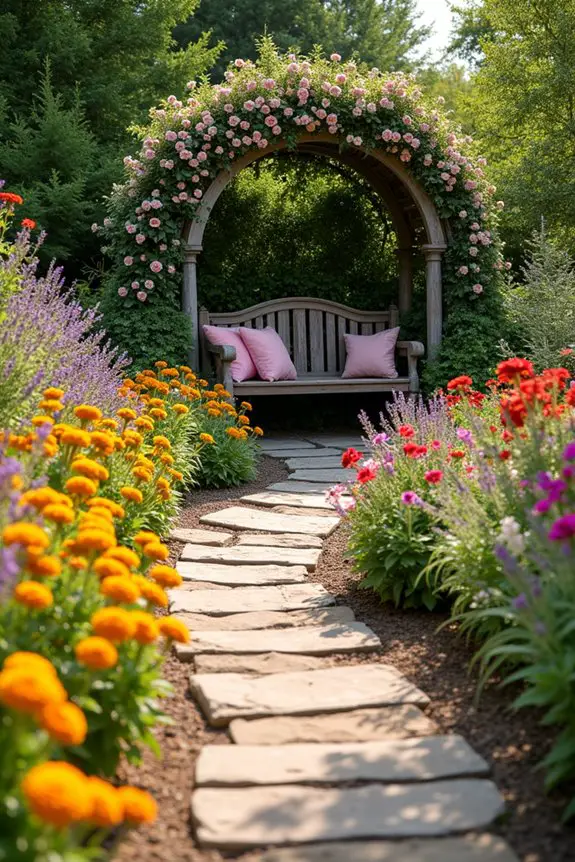
When it comes to small garden design, creating vibrant and inviting pathways is a game changer. These pathways don’t just guide your guests through your little oasis; they set the entire mood. Imagine lush flower beds flanking a charming stone or mulch path, beckoning you to explore every nook and cranny of your garden. It’s like giving your space a warm hug, making it feel cozy and welcoming.
First, think about the materials you want to use for your pathway. Choices like wooden stepping stones, colorful pebbles, or even recycled bricks can add that rustic charm that screams personality. Now here’s a little tip: Try mixing materials for an eclectic look. Just be careful not to create a trip hazard; there’s nothing classy about face-planting into your flower bed. Ouch.
Once you’ve chosen your materials, consider the layout. A winding path can be more intriguing than a straight line. Curves draw the eye and encourage exploration, like a secret garden waiting to be discovered. Incorporating a garden gate arch arbor can further enhance the charm of your pathway, creating an enchanting entry point.
Plant those flower beds on either side in a riot of colors—annuals like marigolds, zinnias, and geraniums can really pop against green foliage. They’ll practically make your pathway sing with joy. Using a soil scoop garden can help you effectively plant and arrange your flowers, making the process smoother.
And while you’re arranging those blooms, think about height. Taller plants toward the back and shorter ones in front create depth and dimension, making flowers more visible. You want your garden to look like an artist’s palette, with layers of color that make people pause and smile. After all, who doesn’t want to stop and smell the roses, right?
Don’t forget to include some seating along the way. A little bench nestled among the blooms can turn your pathway into a lovely spot to enjoy the view.
Imagine sitting there, a cup of tea in hand, with blossoms all around you—pure bliss, really.
3. Sustainable Garden Elements
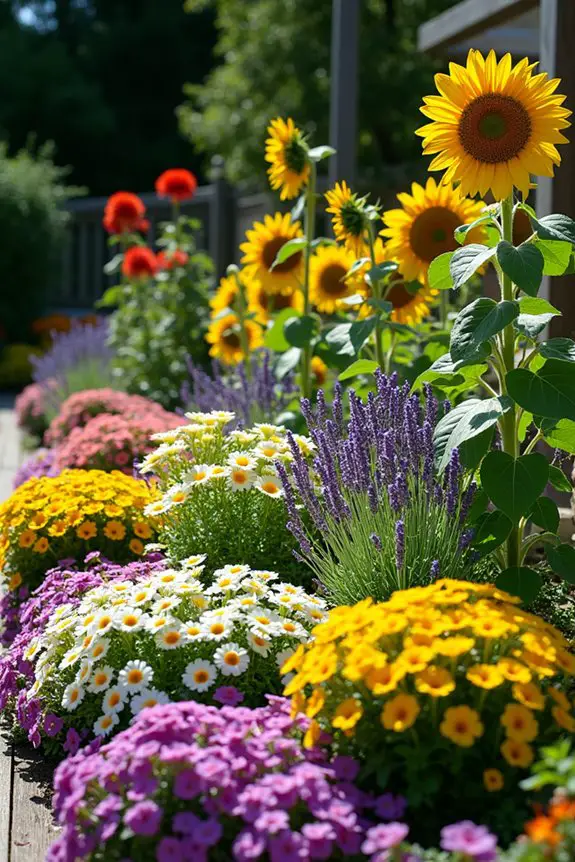
When it comes to adding a splash of life to your small garden, colorful flower beds are an absolute must. They not only serve as eye-catching focal points but also bring a joyful ambiance that makes your outdoor space feel welcoming. Think of them as the cheerful hat that completes the outfit of your garden; they just make everything feel a bit more put together, don’t you think?
To kick things off, consider mixing up your flower selection. Instead of sticking to just one type or color, go for a variety! Pair tall sunflowers with colorful petunias and cheerful daisies. This not only adds a dynamic look but creates a tapestry of textures and hues that’s sure to catch anyone’s eye. You get a sense of whimsy meant to invite exploration and a bit of daydreaming—because who wouldn’t want to escape into a burst of color after a long day?
Pay attention to the planting arrangement, too. Stagger taller flowers at the back and let shorter ones prance in the front—like a fashion show for your flora. Layer them like you’d outfits in your closet. Why wear just one shade when you can mix and match? This technique not only elevates the scene but also guarantees that every flower gets its moment in the sun, literally. No one likes to be overshadowed; not in fashion, and certainly not in the garden.
Now, let’s talk about maintenance. While we all dream of a garden that runs itself, the reality is that these beauties will need a bit of TLC. Regular watering, deadheading spent blooms, and maybe a splash of fertilizer now and then can keep your colorful bed looking like a star.
Set a reminder on your phone, or better yet, bribe a friend with home-baked cookies to help out. (Trust me, it works wonders.)
If you’re looking to sprinkle in some sustainable options, consider including native plants that thrive in your area. Not only do they reduce the need for extra water or care, but they also provide food and shelter for local wildlife. Who knew that practicing sustainability could look so good?
4. Container Garden Concepts
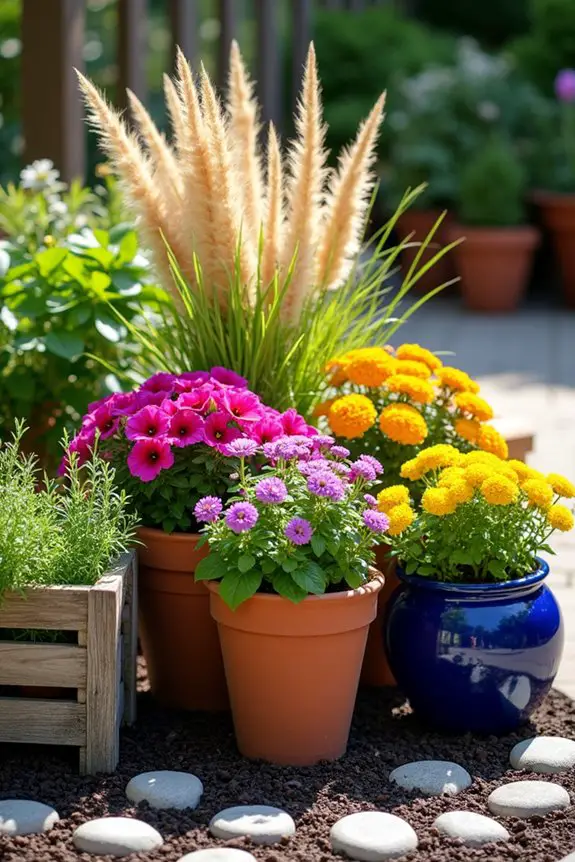
Creating a container garden is a fabulous way to enhance the charm of your small garden space while keeping your floral dreams within manageable limits. Think of it like hosting a dinner party; you want to create a beautiful table setting without overcrowding the plates. With containers, you can achieve that perfect blend of style and practicality.
One of the best things about container gardens is their versatility. You can choose pots of all shapes, sizes, and colors to supplement your existing flower beds or to create standalone interest. Imagine a cluster of terracotta pots splashed with vivid pinks, yellows, and blues. It’s like inviting a whole parade of flowers right to your doorstep. The added bonus? Containers can be moved around to optimize sunlight or to shake things up whenever you fancy a change. Who wouldn’t love that flexibility in their life?
Now, let’s get down to the nitty-gritty of it all. First, consider your containers. Large, small, or somewhere in between, your pots should reflect your personality and the vibe you want to create. If rustic charm is your thing, repurpose an old wooden crate. If you’re feeling a bit glam, opt for shiny ceramic pots. But, don’t forget to verify they’ve drainage holes. Trust me, soggy roots aren’t a crowd-pleaser.
When it comes to planting, keep in mind the thrill of diversity. Mix flowers with different heights, colors, and textures to create visual interest. Try placing a tall ornamental grass in the center, surrounded by shorter, colorful annuals that spill over the edges. It’s like arranging a bouquet, but one that you can savor all season long.
Watering, of course, is another crucial component. Container gardens often dry out faster than traditional beds, so check them regularly—especially on hot days, when you might feel like a cookie crumbling under pressure. A helpful tip: try adding a layer of mulch on top of the soil. Not only does it look snazzy, but it also helps retain moisture. You’ll spend less time watering and more time enjoying your lovely blooms.
And if you’re feeling adventurous, consider growing edibles in containers, too. Imagine plucking fresh herbs or cherry tomatoes to sprinkle on your dinner. With container gardens, the sky really is the limit. After all, who could resist a mini oasis that’s not only pretty but practical? It’s the perfect recipe for garden success. Decorative landscape stones can also add texture and interest to your container garden setup.
5. Garden Furniture Arrangement
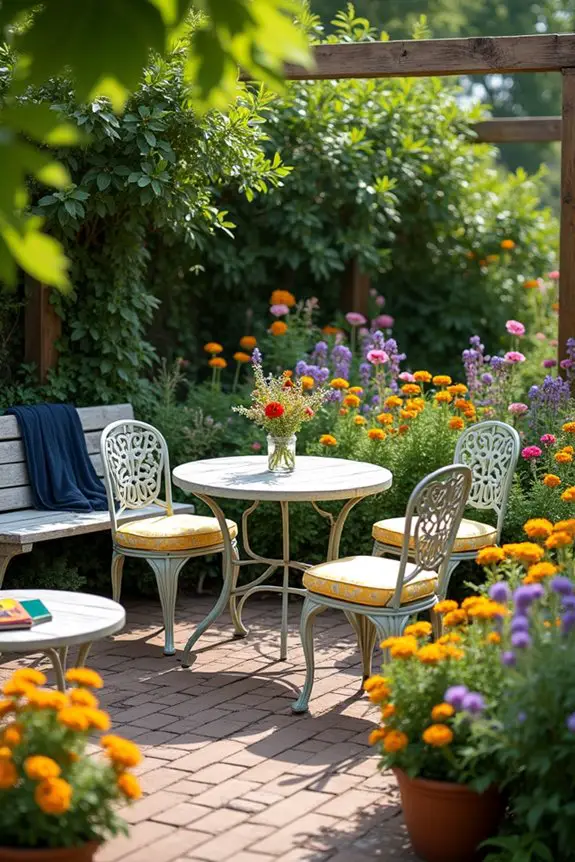
Creating an inviting and functional garden furniture arrangement is like choreographing a dance—every piece should complement each other while adding its own unique flair. The right arrangement not only makes your garden a cozy retreat but also enhances the beauty of your colorful flower beds. Imagine sipping tea surrounded by a rainbow of blossoms; that’s what a well-planned setup can do.
First, think about the layout. You want to create cozy seating areas that feel welcoming. Picture a small bistro table nestled among vibrant marigolds and zinnias, or a comfy bench positioned so you can enjoy the view of your blossoming riot. Spacing is key; you don’t want your furniture to overpower your flowers. It’s like putting on too much cologne—subtlety wins the day.
Next, choose furniture that matches the garden theme. For a rustic vibe, weathered wood tables and wrought iron chairs can add charm, while sleek metal or bright plastic can bring a contemporary twist. I once bought a neon green chair on a whim. It looked fabulous until the garden turned into a wild jungle. Lesson learned—furniture should complement, not compete with your blooms.
Then comes the fun part: accessorizing. Add cushions or throws to your seating for a pop of color and extra comfort. Trust me; there’s nothing like plopping down with a good book and feeling those cozy fabric textures against your skin. You could even throw in a small side table loaded with gardening books (or snacks, let’s be real). This setup invites you to linger longer in your botanical paradise, even if it means ignoring those weeds glaring at you.
Finally, consider the layout dynamics. A circular arrangement around a fire pit creates a warm gathering spot, while linear setups along a path can draw the eye through your flower beds, like a secret garden waiting to be explored. It’s a little bit like setting the stage for your garden’s own performance. You want the flowers to shine, the furniture to invite, and your friends to enjoy every moment.
In this dance of furniture and flowers, remember to keep it playful and personal. After all, your garden should reflect you—quirks included. So go ahead, create cozy spots that allow you to unwind among your colorful blooms, because who wouldn’t want a little slice of paradise right outside their door?
6. Theme-Based Garden Concepts
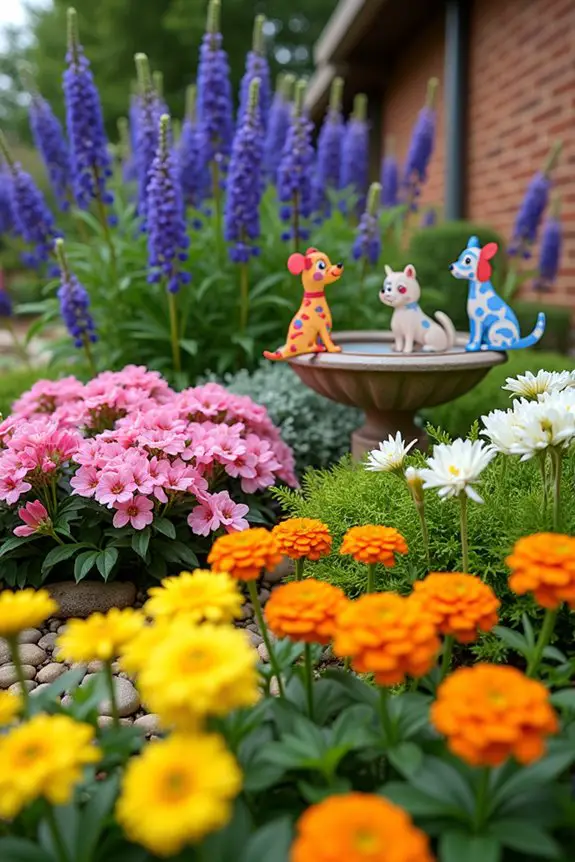
So, you want to create a vibrant and lively garden? Let’s talk about theme-based garden concepts, specifically focusing on those colorful flower beds that make your garden pop. Imagine stepping into a garden filled with an array of colors; it’s like walking into a painter’s palette. Not only do these themes enhance the visual appeal, they also create an emotional atmosphere that invites joy and tranquility.
Start by choosing a color scheme. Think of what makes you happy—maybe it’s the sunny yellows and oranges of summer, or the soothing blues and purples of a serene twilight. You can even mix complementary colors for more impact, like red and green, to create that striking contrast.
And remember, the kind of flowers you select should harmonize with your home’s vibe too. Picture those bright daisies against a rustic brick wall. Perfection, right?
Next, consider planting in layers. This isn’t just about aesthetics; it’s practical too. By arranging taller plants at the back and shorter flowers in front, you’ll guarantee that every blossom has its moment to shine. Think of it as tiers on a cake—who wouldn’t want to see the top tier adorned in gorgeous geraniums?
And if you’re feeling adventurous, try adding some different textures—grassy ferns mixed with fluffy peonies might just create a mini wonderland.
Don’t forget about the seasons! Choose flowers that bloom at different times throughout the year to keep the color flowing. This keeps your garden lively and fresh, like switching playlists to keep the party going.
I made the mistake of only planting summer bloomers once. Come fall, I’d a sad, empty patch—kind of like showing up to a potluck with nothing to share.
Adding a few accents can also bring your theme together. Garden stakes, whimsical sculptures, or even birdbaths can be focal points that blend beautifully with your flowers. They’re like the cherry on top, drawing attention and adding another layer of charm.
Just don’t go overboard—remember, sometimes less is more. I once turned my garden into an art museum, and let’s just say, it became more ‘chaotic gallery’ than ‘delightful display.’
Finally, consider how the overall theme reflects your personality. Your garden should feel like an extension of you. Are you fun and quirky, or serene and sophisticated? Maybe a little of both.
Embrace your unique style and let it shine through your colorful flower beds. After all, your garden is your sanctuary, a reflection of who you are and what you love.
7. Garden Lighting Techniques
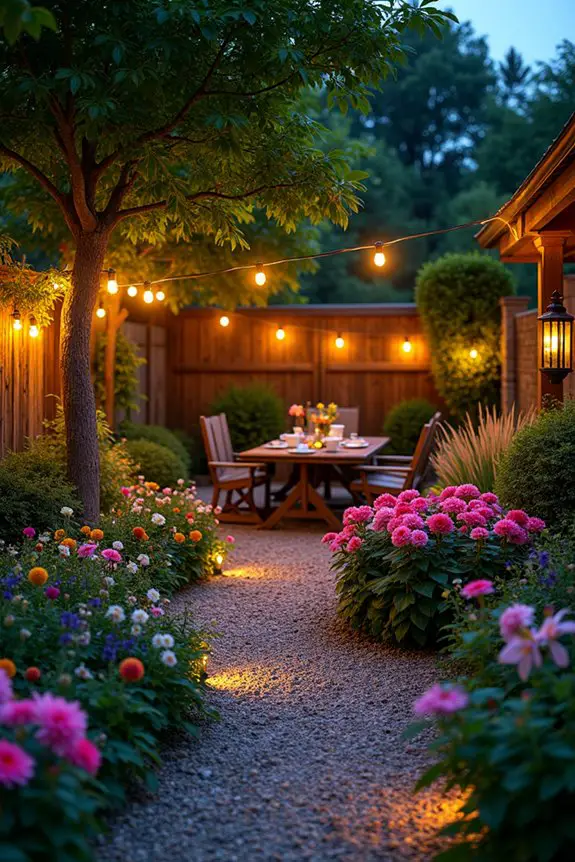
So, you’ve mastered the art of creating vibrant flower beds—now it’s time to spotlight them. Just imagine, as the sun sets and darkness sweeps in, your colorful blooms glowing like treasures. Lighting can completely change the vibe of your garden, making it not just a daytime haven but a magical nighttime retreat too.
Start with path lights. These little beacons are perfect for illuminating walkways, gently guiding visitors through your floral wonderland. Choose soft, warm lights—think cozy glow, not alien spaceship. You want your visitors to feel welcomed, not like they just wandered into a sci-fi movie.
And here’s a tip: I once placed my path lights too close to the plants, and let’s just say, I spent an evening tripping over assorted flowers. Don’t be like me; place them with care.
Next up, consider string lights. These twinkly wonders add a festive charm. Whether strung along a fence, draped over arbors, or entwined in trees, they create a dreamy ambiance. Think of them as the fairy dust of garden decor.
Just remember to avoid overly bright or blinking lights—your garden should soothe, not give folks a case of the jitters. I made the mistake of buying disco lights once, and let’s say my garden turned into a dance party that was more awkward than fun.
Spotlights are another fabulous choice for highlighting your favorite blooms. Aim them at a select few standout flowers to create focal points. It’s like giving them a chance to show off on the big stage.
But keep it subtle; you want a warm pool of light, not some harsh interrogation spotlight. Trust me, nothing kills the evening vibe faster than feeling like a plant in a police lineup.
Lastly, consider solar lights. They’re eco-friendly and perfect for a low-maintenance garden. Just set them up in places where they can soak up sunlight during the day, and watch your garden come alive at night without a single energy bill spike.
I once forgot about solar lights I planted in the shade—surprise! They didn’t glow at all, which was pretty anticlimactic. So pick spots wisely.
Use these lighting techniques to elevate your garden’s charm when the sun goes down. You’ll create an inviting atmosphere, perfect for sipping tea or enjoying laughter with friends. Because who doesn’t want to bask in the glow of their own garden paradise?
8. Textured Plant Combinations
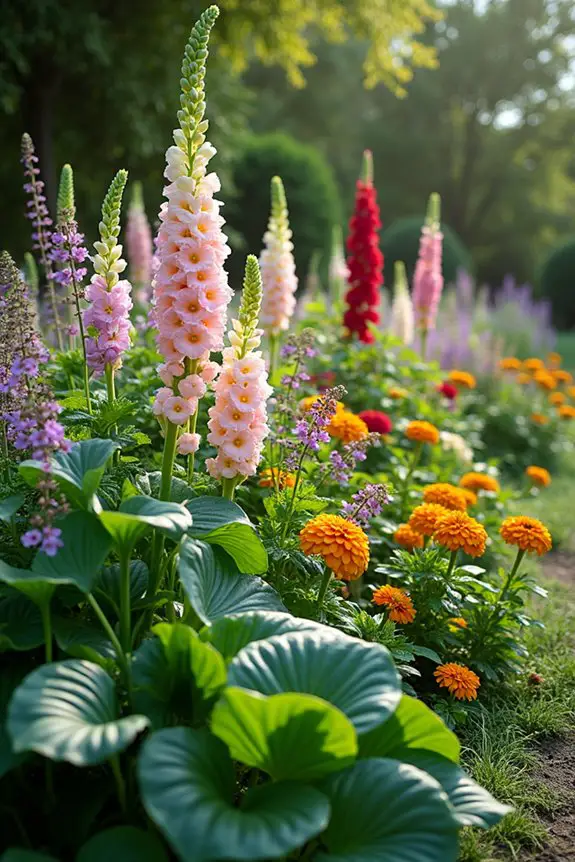
When it comes to creating colorful flower beds, mixing textures is the secret sauce that elevates your garden from simply pretty to absolutely stunning. Not only does it add visual interest, but it also creates a more dynamic environment that dances with life. Visualize strolling through a garden filled with bold, feathery grasses swaying beside delicate, velvety petunias; it’s like a beautiful symphony of nature.
So, where to start? Begin with a strong foundation of foliage. Think about using larger-leaved plants like hostas or elephant ear plants to anchor your beds. Their presence can draw the eye and provide a lush backdrop for more delicate flowers. This contrast is key—those big leaves will make the smaller blossoms pop like confetti at a party.
Now, let’s sprinkle in some finer textures. Flowering plants like snapdragons or sweet alyssum can provide that dainty touch you want. Pair those with some fluffy, feathery plants like ornamental grasses for movement and variety. The trick is to think about heights too. Taller plants, like hollyhocks or sunflowers, can serve as striking focal points, while lower-growing blooms, such as creeping thyme, can fill in the gaps.
Trust me, mixing up the heights will make your garden feel like a layered cake—scrumptious and visually satisfying.
And speaking of scrumptious, don’t forget about color! Combine cool tones like blues and purples with warm yellows and oranges for a delicious contrast. Envision this: bright marigolds nestled next to deep purple verbena. Oh, the joy! It’s like a garden rendition of a sunset.
But in my haste, I once got a bit too ambitious, and let’s just say my flower beds looked more like a chaotic rainbow explosion rather than a serene landscape. A little planning goes a long way.
Finally, consider adding some evergreen elements for texture all year round. Plants like hellebores or ever-fabulous ferns can keep your beds lively even when the flowering stars take a break in the colder months. A bit of green in winter can turn a drab landscape into something charming.
Combine these textured plant combinations to create an eye-catching garden that not only looks good but feels invigorating too. Your outdoor space will transform into a relaxing oasis that invites time-well-spent, whether you’re sipping a cool drink on a summer evening or gawking at the flurry of life in the spring. Who knew a few plants, neatly arranged, could spark such joy?
9. Smart Space Utilization
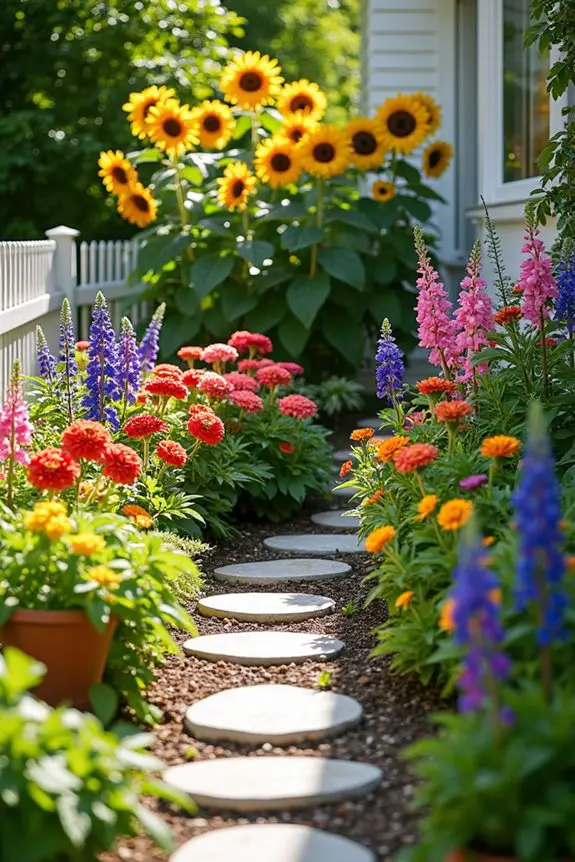
Creating colorful flower beds in a small garden can feel like a challenging puzzle, but don’t stress. With some smart space utilization, you can turn that tiny plot of land into a vibrant canvas.
By layering plants, playing with heights, and using strategic placements, you not only maximize your garden’s potential but also cultivate a welcoming vibe that invites you to relax and enjoy.
First off, think about vertical gardening. If you’re dealing with limited ground space, go up! Tall plants, such as sunflowers, can be planted at the back of your flower bed, while shorter flowers like pansies can take the spotlight at the front.
This tiered approach creates visual intrigue and makes sure every single bloom gets its moment to shine. I once planted a mix of zinnias and delphiniums, and let me tell you, watching those blooms rise and fall was like seeing a charming little parade in my own backyard.
Next, consider using containers. They’re your best friends in small spaces, transforming every nook and cranny into a potential garden spot. A few colorful pots filled with cheerful geraniums or fresh herbs can instantly jazz up that lonely corner of your patio.
And guess what? These containers can be moved around whenever the mood strikes—perfect for undecided gardeners like me. There was this one time I rearranged my pots so many times that my neighbors probably thought I was auditioning for a gardening reality show.
Choose a color palette that flows together, but don’t shy away from bold splashes. Mixing complementary colors creates a lively atmosphere while sticking to a few main colors can keep things cohesive.
I tried to combine every shade of the rainbow once, and let’s just say it ended up looking like a clown convention rather than a peaceful retreat. So, maybe pick two or three main shades to work with. Your garden will thank you.
Lastly, don’t forget about pathways. If you can create little walkways or stepping stones in your flower beds, they serve a dual purpose. Not only do they make your garden accessible, but they also guide visitors through your colorful masterpiece in a way that feels intentional and proud.
My path of stepping stones led to a hidden herb garden that accidentally turned into a gathering spot for my friends. Who knew basil was the ultimate icebreaker?
10. Seasonal Plant Arrangement Strategies
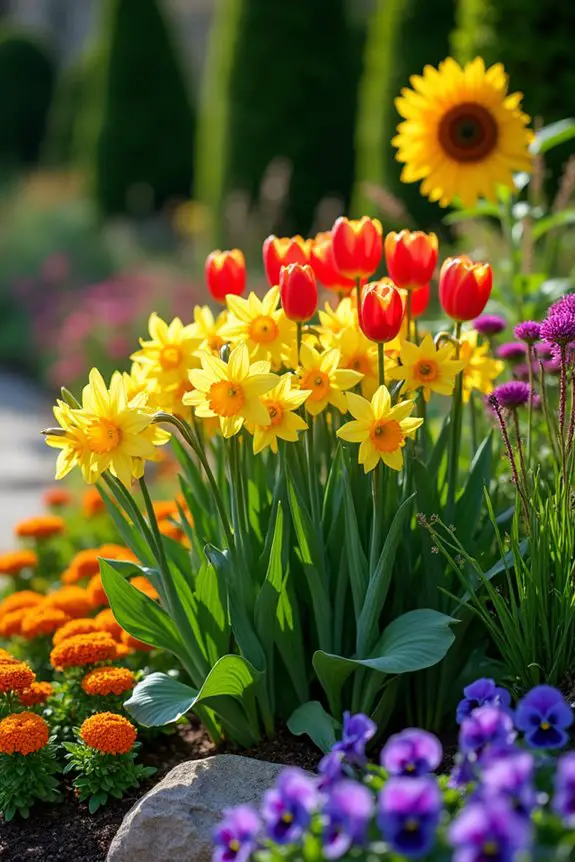
When it comes to creating those stunning flower beds, think about seasonal plant arrangements. This strategy is like a wardrobe change for your garden, making certain it’s never out of style. By selecting flowers that bloom at different times, you can keep your garden looking lively and fresh all year round. It’s not just about aesthetics, either; you can enjoy the ever-changing beauty while also supporting local pollinators and wildlife, which is a win-win for everyone.
Start with a solid foundation. Select some evergreen perennials that will provide structure. Think of these as the boring but dependable friends who keep things steady. Plants like daylilies, hostas, or even boxwoods add structure year-round, giving a solid backdrop for everything else. Last summer, I planted a row of evergreens along the back, and it was like putting a sturdy frame around a beautiful painting.
Next up is the fun part—choosing seasonal bloomers. For spring, think cheerful tulips and daffodils that practically shout, “Hey, winter, don’t let the door hit you on the way out!” As summer rolls in, add bright sunflowers and zinnias to keep the mood light and vibrant. Autumn calls for warm hues with marigolds and asters, creating an easy conversion to those cozy vibes.
And don’t overlook winter; there are beautiful options like hellebores or winter jasmine that make certain even in the cold months, your garden is alive with character. I once waited all winter for my hellebores to bloom, and being greeted by those delicate flowers was like stumbling upon a hidden treasure after a long search.
Think about layering too. When arranging your plants, place the taller ones towards the back, the medium-height blooms in the middle, and the cute, short guys at the front. This tiered effect creates depth and makes certain every flower gets seen. Just be careful—I’ve been known to plant tall sunflowers a bit too close to the shorter ones, only to find them casting shadows that made my beloved pansies sulk in sadness.
Lastly, don’t be afraid to mix in some grasses or interesting foliage. These can add texture and give your flower beds an eye-catching twist. Grasses swaying in the wind create movement, like nature’s little wave, while colorful leaves can be a stunning contrast against your blooms.
I once mixed in some red-twig dogwoods with my flowers, and the punch of color made it look like my garden was strutting down a fashion runway.
Effective Watering Techniques
Have you ever watched a plant wilt in the baking sun and thought, “What did I do wrong?” Watering might seem like a simple task, but nailing it’s essential for your garden’s success.
Picture your small garden design ideas layout, with rows of thirsty plants, begging for a drink. To keep them happy, water early in the morning or late in the evening. Deep soaking is the way to go—about an inch a week, and trust me, they’ll flourish.
Use a soaker hose or a watering can for precision, and avoid the “quick sprinkle” technique. And here’s my little secret: I often forget, so I set my phone reminders. Just think of it as a daily hydration routine—your plants will thank you.

